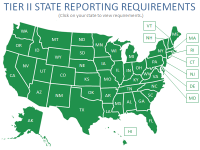Today’s workplace uses thousands of chemicals, many of which are hazardous. The resources in this section will help guide you in the safe and legal identification, storage, transport, and use of these chemicals, and in making sure that your employees right to know how to be safe around such substances is provided, as required by law.
The deadline to submit Tier II reports is March 1. Do you know your state’s reporting requirements? Section 312 of the Emergency Planning and Community Right to Know Act (EPCRA) requires facilities storing hazardous chemicals above certain thresholds to submit an annual inventory of those chemicals to the State or Tribal Emergency Response Commission (SERC/TERC), […]
Q: When questioning whether a chemical is reportable under SARA 312 Tier II what’s the best way to make that determination? Other than exceeding the 10,000 lb quantity on hand, what makes a chemical reportable under Tier II?
The Tier II reporting deadline is approaching. This infographic provides essential information to help you determine if you need to report, along with some helpful tips for preparing and submitting a Tier II report.
The U.S. Chemical Safety Board (CSB) has published its 2016 Impact Report, a compilation of accident investigations the CSB completed in fiscal year 2016; ongoing accident investigations; recommendations to regulatory agencies, state and local government, and industry organizations; CSB’s advocacy and outreach initiatives; and expansion of its list of drivers of critical chemical safety change.
According to the American Cancer Society, about 40 percent of Americans will develop cancer during their lifetime, and about 20 percent will die of cancer. An unknown percentage of these cancers are caused by workplace exposure to carcinogens. To aid in the prevention of occupational cancer, the National Institute for Occupational Safety and Health (NIOSH) […]
The behavior of many common chemicals is, by now, predictable in most circumstances. But when a very common substance (for example, carbon) is broken down into individual molecules and rebuilt into an extremely tiny structure (for example, a tube of carbon “rings”), its chemical behavior is entirely differently from the same substance in a larger […]
On December 22, 2016, The American Farm Bureau Federation and the National Association of State Departments of Agriculture (AFBF/NASDA) petitioned the EPA to delay by 1 year the January 1, 2017, compliance date for the Agency’s revised standards to improve protections for farm workers who apply or otherwise handle or are exposed to pesticides (Worker […]
The EPA has taken final action to remove 72 entries from the list of inert ingredients approved for use in pesticide products. Inert ingredients on this list do not need further approval before inclusion in a pesticide formulation for a nonfood use.
Have you enjoyed a tasty cup of flavored coffee or delicious hot buttery popcorn lately? That rich flavor probably came from an extracted and concentrated form of one or more naturally occurring chemical substances—substances that, in their pure chemical form, have the very chemical-sounding names of diacetyl and 2,3-pentanedione.
The EPA is proposing to use its authority under Section 6(a) of the Toxic Substances Control Act (TSCA) to prohibit several uses of trichloroethylene (TCE), a volatile organic compound, to eliminate exposures to workers, consumers, and the general population, which, the Agency says, result in significant cancer and noncancer health risks. The proposal would specifically […]










